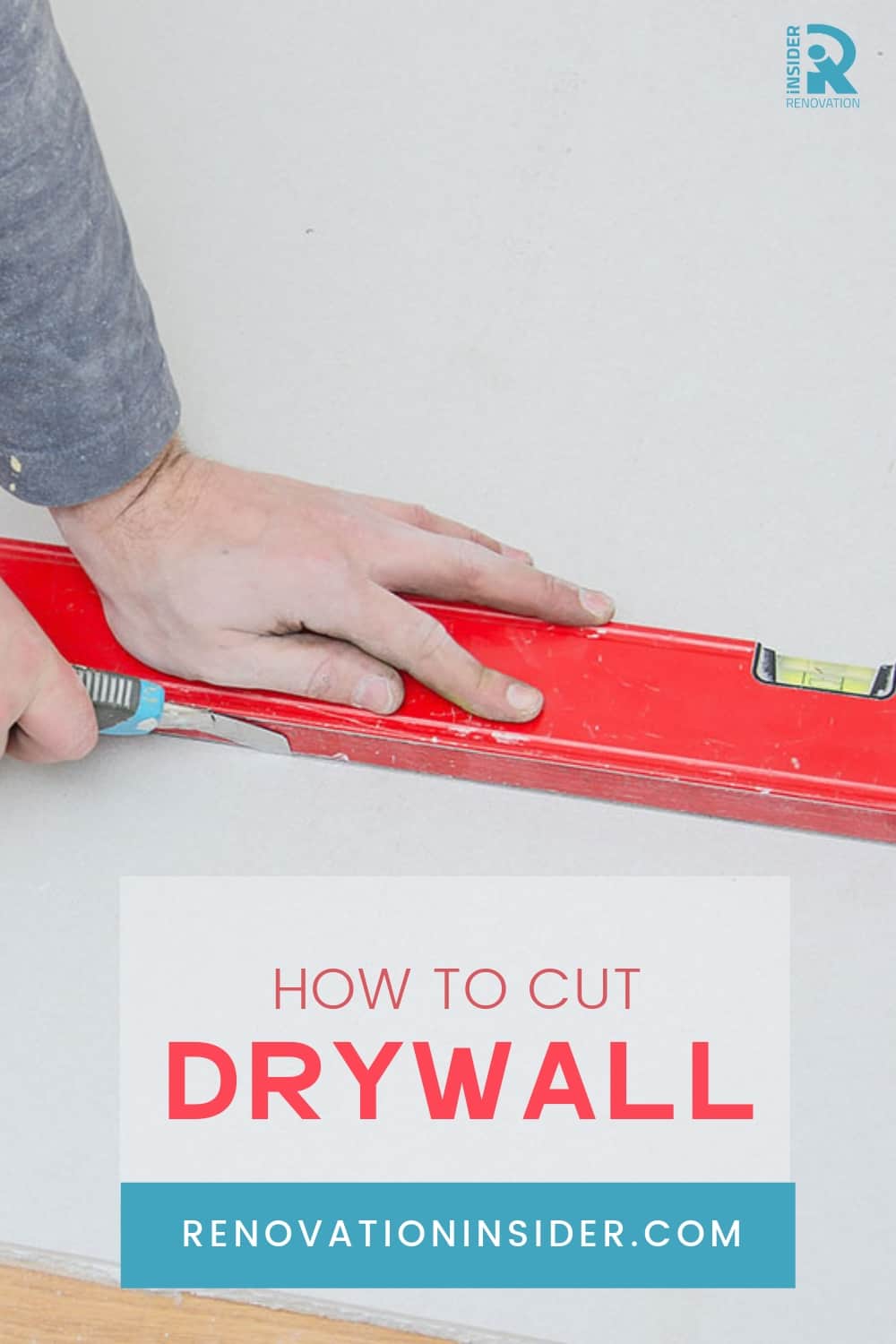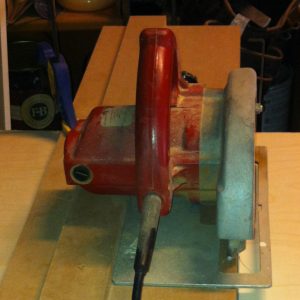How To Cut Drywall – The 10 Top Tools
We all need to know how to cut drywall. It’s going to come up in many renovation projects. Knowing how to cut it is one thing. Knowing how to do it like a pro is another!

Drywall is literally all around us. If you’re reading this in an office, chances are that every wall surface around you is made of drywall. And if you’re at home, your walls and ceilings are most likely made of drywall.
Over the last decades drywall has replaced plaster in most North American homes. Why? Because it’s cheaper and it’s much easier to work with.
How To Cut Drywall
Cutting drywall is not a really precise trade. And so the tolerances for measuring and cutting sheetrock are greater than for almost any other finish material.
Strike a line or use a t-square as a guide. Cut through the paper on the front of the drywall. Turn the piece of drywall over and snap it along the line of your cut. Then fold the sheet of drywall and cut the back paper to finish the job.
In general, tape and compound will cover every cut you make so allow yourself some wiggle room. For instance, if you’re installing a board on a partition and your tape measure reads that you have 63-1/4″ of space, cut it at 63”.
When you first begin to cut sheetrock you’ll want to make sure that you don’t cut sheetrock too tight. Because you’ll end up having to shave off an ⅛” or a ¼”.
Although most of the time precision isn’t required, there are some exceptions. The holes for recessed ceiling fixtures have to be dead-on. And there’s not much play in the hole size for outlets and switches.
How To Cut A Circle In Drywall
When you’re cutting holes for ceiling fixtures before you install the drywall, use the jab saw to make the circular cut-outs. But if the drywall is already installed, a hole saw (with a dust hood) will be more precise.
You don’t have to use a hole saw, the jab saw will work for you if you’re careful.
How To Cut A Hole In Sheetrock
For this use a Sheetrock Saw or Keyhole saw.
Let’s say it’s a hole for an outlet or switch. Once you’ve measured and marked the sheetrock, hold the point of the saw against a line on the sheetrock. Then smack the heel of the saw with one hand (or use a hammer!) to drive the point of the saw through.
The sheetrock saw does create silica dust. Wear a face mask. Vacuum up the dust. Or if you have a helper, have them hold a vacuum cleaner hose in the dust stream.
10 Useful Tools to Cut Drywall
With almost every remodeling project, you’ll need to cut, repair, or install sheetrock. Here’s a list of the tools you’ll need along with some tips.
No. 1 – Utility Knife
Choose a knife that allows the blade to be retracted into the knife body and one that holds extra blades.
Be sure to change out the blades once they are dull. (drywall is hard on knife blades!). A dull blade is more dangerous to use than a sharp one is because it takes more effort which makes it more likely you’ll lose control of the blade.


Pros: Very inexpensive tool, simple to use and cutting drywall with a knife creates very little dust.
Cons: Not necessarily easy to use well; it takes some practice to be able to cut a straight line freehand.
No. 2 – Jab Saw

I happen to prefer the wood-handled version of this tool because if I need to hit the handle with a hammer to drive the blade through, the wood handle makes that task easier.
Pros: A jab saw is a very inexpensive tool that is simple to use and is very versatile. Use a jab saw to cut a hole for an electrical box or a light as well as cutting odd-shapes to meet your needs.
Cons: Cutting drywall with a saw creates dust. But the dust created with this saw usually falls to the floor quickly.
You could stop right there! These two tools can handle almost all of your drywall cutting. But, the other tools on this list will make your job easier and result in a better quality installation.
No. 3 – Chalkline

You might already have a chalkline in your toolbox. Now’s the time to take it out and make sure it still has chalk in it!
A chalkline is the easiest way for you to mark full boards of sheetrock for cutting.
Normally you’ll need two people to use a chalkline. But there’s a simple trick to use the chalkline when you’re working by yourself. Let’s say you need to cut a 4’X 8′ sheet down to 20″ X 96″. Mark 20″ on one end of the board.
Take your knife and slice into the end of the drywall board going all the way through the sheet. Slide the end of your chalkline into the cut you’ve just made and it will hold securely in place. Now you don’t need a helper to hold the other end! Just unreel the line till you’re at the other end of the board, and snap the line.
PRO TIP: The pros learn to use their tape measure and pencil to mark a straight line – or not bother with striking a line and just use their tape and knife to measure and score in one movement. Hey, time is money for these guys!
No. 4 – Drywall T-Square


Pros: Inexpensive and one of those ‘Where has this tool been my whole life?!’ The Drywall T-Square makes short work of cross-cutting sheetrock with a utility knife. The lines will be perfectly straight and square.
Cons: None I can think of!
No. 5 – Drywall Rasp
This inexpensive little tool is used to shave material off the edge of a board of sheetrock. Think of it as a block plane for drywall. It’s held and used in the same way a block plane is used.
It can straighten the edges of a cut board. It can make your board just a little bit smaller if it won’t quite fit.
Pros: The Drywall Rasp is great for taking just a little bit of sheetrock off an edge or for increasing the size of an opening slightly. It can also be used on an outside corner where one board might extend a little beyond the other corner board.
Con: It does create dust. So sweep up or use your vacuum right after using the rasp and you’ll save yourself lots of cleanup time and frustration later!
No. 6 – Sheetrock Saw

This is like a carpenter’s rough handsaw just shorter.
Pros: Cuts sheetrock in a straight line very quickly.
Cons: Dust is the only con here. But, cutting with any of the power tools mentioned below will create much more dust.
No. 7 – Hole Saw
A hole saw is a tool you’re only going to use if you’re working on drywall that’s already in place. So for instance, a hole saw comes in handy when you want to make the hole for a recess light fixture. Having a hole saw makes a great addition to any toolbox, but it is by no means essential.

Pros: Using a hole saw is quick; it’s precise and if used with a dust-hood avoids any mess.
Cons: If you don’t use a dust-hood, the dust created will travel far and wide!
No. 8 – Dust Hood
A dust hood is a clear plastic bowl designed to contain dust and shavings when you’re using a hole saw.
It’s is another non-essential tool, but it still makes a great addition to any tool collection. And it’s especially useful when you are working on a repair project. There are other methods of dust projection for larger remodeling or renovation projects.
A dust hood, however, is perfect when you just want to minimize dust during a quick repair job. Especially if you are concerned about family members with allergies in your house!
No. 9 – Oscillating Multi-Tool
The oscillating multi-tool is a real game-changer. If you don’t already own one, put it on your shortlist! It’s another tool that really shines when you want to quickly cut out a piece of existing drywall.
Like the name implies an oscillating multi-tool can do many jobs besides cutting drywall (cut, sand, prep for paint …). You’ll be surprise how often you’ll reach for it and wonder how you ever lived without it.
I recommend the 20-Volt cordless version.
Pros: You can cut installed sheetrock very precisely and with very little effort.
Cons: The multitool will create very fine dust that’s difficult to contain or control. Noise. A oscillating multi-tool is very noisy.
No. 10 – Rotary Drywall Cutter

This tool is used for cutting out holes for outlets, switches, lights etc. Ridgid’s Jobmaster Rotary Cutter is an excellent tool for tight spaces.
Pros: you’ll get a precise hole very quickly. If you’re used to working with a trim router, this tool will be second nature to you
Cons: Dust. If you decide to use this tool, recruit a helper to hold the hose of the shop vac close to the work to collect as much dust as possible.
Cut A New Board In A Straight Line
It’s a three-step process: cut the face paper with the utility knife, flip the sheetrock over and “break it” on the cut line. Bend it 90 degrees and cut the back paper.
















Really helpful especially for the DYI folks! Thank you!
Thanks for this guide. Do you have any particularly good tips for sawing drywall straight?